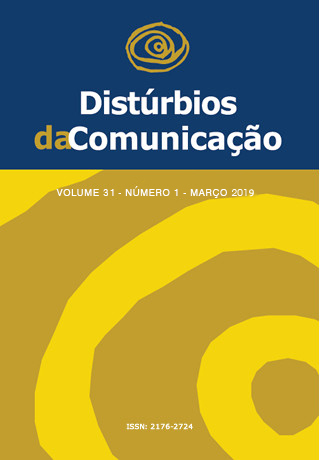Functional and epidemiological outcomes of swallowing in supratracheal laryngectomy with traqueohyoidoepiglottopexy
DOI:
https://doi.org/10.23925/2176-2724.2019v31i1p87-94Keywords:
Speech, Language and Hearing Sciences, Epidemiology, Laryngectomy, Deglutition.Abstract
Introduction: Supratracheal partial laryngectomy (STPL) is a current alternative for surgical intervention, indicated for the treatment of intermediate / advanced laryngeal tumor. When its resection is broader than predicted by this technique, we add the term “extended” to its nomenclature. Its reconstruction is made, among variations, by traqueohyoidoepiglottopexy (THEP). The main complications of this procedure are related to swallowing and breathing. Objective: To characterize the selected population and to evaluate functional aspects of swallowing in extended STPL by THEP reconstruction. Method: Observational cross-sectional study on patients of both sexes with laryngeal neoplasm submitted to extended STPL by THEP in a cancer hospital from 1995 to 2017. A study of the medical record, consultation on the surgical system, Videofluoroscopy Swallowing Study and application of the scale National Outcomes Measurement System of the American Speech-Language Hearing Association (ASHA NOMS) were made. Results: 10 men, aged between 52 and 83 years (median 69), 80% smokers and alcoholics at diagnosis; T2 [70%], T3 [30%]. Results of videofluoroscopy of swallowing: 100% stasis on tongue base, 80% on vallecula, arytenoid (s) and pyriform recess, 40% on upper esophageal sphincter and 30% on posterior wall of pharynx; 30% presented aspiration. All of them presented oral nutrition and hydration. Conclusion: Male patients, mostly elderly, alcoholics and smokers with intermediate and advanced tumor staging. All of them had nutrition and hydration capacity without alternative food routes. The swallowing function was satisfactorily restored with specialized speech therapy at all times of treatment. Patients with more than nine months of surgery had better functional results.Downloads
Metrics
Downloads
Published
How to Cite
Issue
Section
License
Copyright (c) 2019 Guilherme Maia Zica, Andressa Silva de Freitas, Werlany Frois Maia Lopes, Bárbara Luiza Marinho da Silva, Fernanda Gonzalez Rocha Souza, Emilson Queiroz Freitas, Izabella Costa Santos, Fernando Luiz Dias, Márcio José da Silva Moreira

This work is licensed under a Creative Commons Attribution 4.0 International License.






